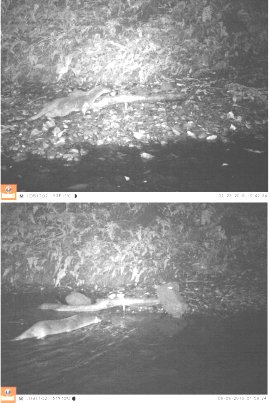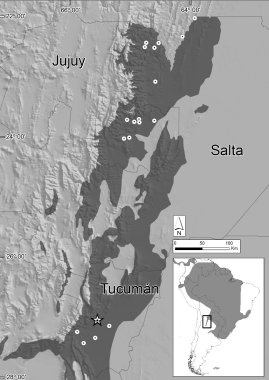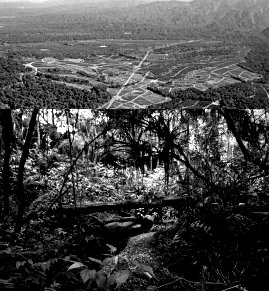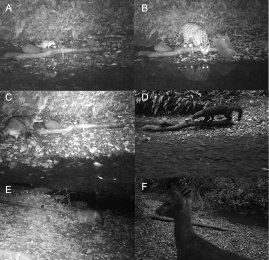IUCN/SSC Otter Specialist Group Bulletin

©IUCN/SCC Otter Specialist Group
Volume 34 Issue 1 (January 2017)
Citation: Albanesi, SA, Jayat, JP, Alberti, P and Brown, AD (2017). New Record of River Otter (Lontra longicaudis Olfers, 1818) in the Extreme South of Yungas of Northwestern Argentina. IUCN Otter Spec. Group Bull. 34 (1): 19 - 28
New Record of River Otter (Lontra longicaudis Olfers, 1818) in the Extreme South of Yungas of Northwestern Argentina
Sebastián A Albanesi1*, J. Pablo Jayat2,3, Paola Alberti4 and Alejandro D. Brown1
1 Fundación ProYungas (FPY), Perú 1180, 4107, Yerba Buena, Tucumán, Argentina Email: sebastianalbanesi@gmail.com
* Corresponding Author
2Instituto de Ambiente de Montaña y Regiones Áridas (IAMRA), Universidad Nacional de Chilecito. CP: F5360CKB, Chilecito, La Rioja, Argentina
3Instituto de Ecología Regional, Laboratorio de Investigaciones Ecológicas de Las Yungas (IER- LIEY), Universidad Nacional de Tucumán. CC 34, Yerba Buena, Tucumán, Argentina
4Facultad de Ciencias Naturales e Instituto Miguel Lillo, Miguel Lillo 205, 4000, Tucumán, Argentina
    |
| (Received 25th October 2016, accepted 12th January 2017) |
| Download PDF (2.5 MB) |
| Abstract: The neotropical river otter (Lontra longicaudis) has scarce distribution records in Northwestern Argentina (NWA); most of them are old, inaccurate, and/or coming from mentions not well corroborated. We report filmic and photographic records of this species from the piedemont of Yungas of the southern NWA obtained in riparian forest patches located in citrus farms in Tucumán province. The record is important by the scarcity of information, but also because this otter have its southernmost distribution in the western portion in this area, it is a taxa with conservation concerns, and the records come from a natural environment heavily modified. |
| Keywords: Distribution. Lutrinae. Mustelidae. New record. Subtropical forest. Neotropical river otter |
| Française | Español |
The Yungas forest acts as an important corridor in the dispersion of elements from Amazonia toward Northwestern Argentina (NWA; Ojeda et al., 2003). In this region, the Yungas reach their southernmost distribution, and although it has a discontinuous distribution and wedge-like or peninsula shape between arid and semiarid environments (Ojeda et al., 2008), they shelter a large part of the biological diversity of terrestrial mammals of medium and large-size of Argentina (Barquez et al., 2006). For this environment, 37 species included in the Artiodactyla, Carnivora, Cingulata, Didelphimorphia, Lagomorpha, Perissodactyla, Pilosa, Primates and Rodentia orders have been reliably recorded (e.g., Olrog, 1979; Mares et al., 1981,1996; Ojeda and Mares, 1989; Heinonen and Basso, 1994; Capllonch et al., 1997; Jayat and Ortiz, 2010; Jayat et al., 2009).
Although this Yungas species list has been relatively well established, most of them are known through few records, many of which are historic or come from unreliable sources. Thus, the presence of some species for certain areas is assumed, or is considered probable, without an appropriate documentation. One of the most notorious cases of this, is the neotropical river otter ( Lontra longicaudis Olfers, 1818), of which there are just 18 georeferable records for Yungas of NWA (Table 1).
Most mentions of this species for this ecoregion are old, unspecific in their locality of origin, and/or come from unconfirmed occasional mention. Furthermore, they are mostly clustered in the Alta Cuenca del Rio Bermejo (ACRB) in the North of NWA (Fig. 1). The presence of this species in the Argentina's southern Yungas end has such insufficient bases that their scanty records were not considered in the most comprehensive study of this species distribution in South America (Rheingantz et al., 2014).
In this study, we report filmic and photographic records of this species from the Piedemont of Yungas of the Southern end (Province of Tucuman) obtained during biodiversity surveys of mammals, realized in an environmental strategy frame of the citrus company San Miguel.
We obtained the records (Fig. 2) during the month of September, 2015, and July and August, 2016 through Bushnell HD cameras trap, programmed to shoot three photos and record a video of 20’’ long, with a delay time of 5’. The cameras were installed on the banks of a stream that runs along forest patches of Yungas inmersed in citrus plantations inside the Caspinchango property. The cameras were baited with a can of tuna attached to a trunk and placed at a 2 m distance. The exact locality of the records is approximately 13 km east of Famailla City (Famailla Department, 27°2'36.84"S, 65°32'52.96"W).
 |
|
Figure 2 . Photographic records of neotropical river otter (Lontra longicaudis) in the piedemont of Yungas in the Caspinchango property, Tucuman, Argentina (click for larger version) |
The environment in the area where the record was made is a forest dominated by cebil colorado (Anandenanthera colubrina), tipa (Tipuana tipu), pacara (Enterolobium contortiticiliquum), laurel (Cinnamomun porphirium), nogal (Junlans australis), san antonio (Myrcine laetevirens), chalchal (Allophilus edulis), amyruca (Psychotria cartaginensis) and ramo (Cupania vernalis). Some exotic tree species such as ligustro (Ligustrum lucidum), higo (Ficus carica), and naranjo (Citrus sp.) also were present, although with minor abundances. We observed large amount of epiphytes (bromelias, mosses, lichens) and standing and fallen dead trees in a densely covered understory of ferns and seedlings of chalchal (Allophylus edulis) (Fig. 3).
The stream has a maximum depth of 1 m, usually in the pools, and a width of 3 to 4 m, and in some portions we observed steep walls, beach sectors, trunks and rocks that stand out of the water. The water level is minimal and constant throughout the year, however in the rainy season flow increases abruptly for a short period of time (Fig. 3).
Other species of medium and large sized mammals recorded at the same site included the Massoia’s lutrine opossum (Lutreolina massoia), tayra (Eira barbara), crab-eating raccoon (Procyon cancrivorus), crab-eating fox (Cerdocyon thous), gray brocket (Mazama gouazoubira), and the ocelot (Leopardus pardalis) (Fig. 4). In addition, we recorded the white-eared opossum (Didelphis albiventris), collared Peccary (Pecari tajacu), jaguarundi (Puma yaguoroundi), and the pampa fox (Lycalopex gymnocercus) near of sampling sites and within the same property.
The neotropical river otter recently was considered present in the province of Tucuman (Barquez et al., 2006), but with only four records of its presence (Fig. 1, Table 1). Two of them, from the Colorado River (Leales Departament) and Concepcion (Chicligasta Departament) are reliable records of this species since they belong to specimens of the Lillo Mammals Collection (CML 00065 and 00208, respectively). However, these records, frequently repeated in the literature (e.g. Lucero, 1987; Mares et al., 1996) are old, corresponding to collections made in 1979 and 1925, respectively. Heinonen Fortabat and Chebez, (1997) also mentioned this species on the Campo de los Alisos National Park, probably on the basis of skins of this species observed in an area known as “Los Chorizos” at 1100 m altitude (Jayat et al., 2009). An additional record, which until now was not properly documented, corresponds to mentions by settlers who noted the presence of this species at the stream “El Salton” in the Santa Ana Provincial Reserve (Jayat et al., 1999).
Records obtained in the present study confirm the presence of this species in the Piedemont of Southern end of Yungas of NWA, and are the only reliable current citation of the species for the area. This finding is important because it comes from a region recently considered as a priority for studies of species’ presence (Rheingantz et al., 2014). This record is not only important due to the scarcity of information, but also because it is found of the species Southern limit distribution, and for being considered a taxón “almost threatened” internationally (http://www.iucnredlist.org/details/12304/0) and “endangered” nationally (Ojeda et al., 2012), and coming from a natural drastically changed environment. The piedemont constitutes the altitudinal floor of Yungas that has historically experimented great anthropic pressure, representing the most threatened environment of this ecoregion and one of the most compromised forests at a national level (Brown et al., 2006; Brown and Malizia, 2014). Although this environment presents a significant area (approximately 900000 ha) with a proper state of conservation according to ACRB, at the Southern end the situation is completely different. In Tucuman this environment persists as relatively small patches and corridors immersed in a crops matrix, usually sugar cane and citrus, which dominate the landscape. According to our studies, these areas despite being small, strongly fragmented, and at different states of conservation, seem to be a key refuge for many species of mammals. In this context, the establishment of baselines of the species diversity found there is an essential condition for the implementation of conservation polices. Knowledge about the presence and status of mammal population in these areas is important in the conservation of this ecosystem, since their presence is an indication of healthy environmental conditions. The specific case of river otter would allow inferring physicochemical conditions of water, habitat structure and food availability of appropriate resources (Rheingantz et al., 2014).
The cameras trap surveys actually have become a valuable tool to perform inventories and monitoring of cryptic species (Moraes and De Miranda, 2003; Karanth et al., 2004; Tobler et al., 2008). The effectiveness of this approach to the study large and medium size mammals, especially those most elusive species has been demonstrated in research carried out in moist forest areas, (Tobler et al., 2008; Rovero et al., 2014) incluiding environments of Yungas (Jiménez et al., 2010; Di Bitteti et al., 2013; Albanesi et al., in press). The records obtained in this study confirm their usefulness and encourage to think about the possibility of new and interesting findings.
Acknowledgements: This work would not have been possible without the help of J. Jimenez, M. Rojas, and R. Ordonez who collaborated actively in the field tasks. Most of the surveys were carried out with funds provided by the citrus company San Miguel and National Forest Direction (Law N° 26.331 of Minimal Budgets of Environmental Protection of The Native Forest). This work had the institutional support of the ProYungas Foundation (FPY), The Laboratory of Ecological Investigations of the Yungas of the Institute of Regional Ecology (LIEY- IER), and The National Council of Scientific and Technological Investigations (CONICET).
REFERENCES
Albanesi, S.A., Jayat, J.P., Brown, A.D. in press . Patrones de actividad de mamíferos de medio y gran porte en el pedemonte de Yungas del noroeste argentino. Mastozoología Neotropical.
Barquez, R.M., Díaz, M.M., Ojeda, R.A. (Eds.). (2006). Mamíferos de Argentina, sistemática y distribución. Sociedad Argentina para el Estudio de los Mamíferos, Tucumán.
Brown, A.D., Malizia, L.R. (2014).Las Selvas Pedemontanas de las Yungas: en un umbral de la extinción. Ciencia hoy 83 :52-63.
Brown, A.D., Pacheco, S., Lomáscolo, T., Malizia, L.R. (2006). Situación ambiental de los Bosques Andinos Yungueños., In: Brown, A.D., Martínez Ortíz, U., Acerbi, M. y Corcuera, J., (Eds.). La situación ambiental Argentina. Fundación Vida Silvestre Argentina, pp. 53-61.
Capllonch, P., Autino, A.G., Díaz, M., Barquez, R.M., Goytia. M. (1997 ., Brown, A.D. (2013). The effect of anthropic pressures and elevation on the large and medium-sized terrestrial mammals of the subtropical mountain forests (Yungas) of NW Argentina. Mammalian Biology 78 :21-27.
Di Bitetti, M.S., Albanesi, S.A., Foguet, M.J., De Angelo, C., Brown, A.D. (2013). The effect of anthropic pressures and elevation on the large and medium-sized terrestrial mammals of the subtropical mountain forests (Yungas) of NW Argentina. Mammalian Biology 78:21-27.
Heinonen, S., Bosso, A. (1994). Nuevos aportes para el conocimiento de la mastofauna del Parque Nacional Calilegua (Provincia de Jujuy, Argentina). Mastozoología Neotropical , 1 (1):51-60.
Heinonen Fortabat, S., Chebez, J.C. (1997). Los mamíferos de los parques nacionales de la Argentina. Monografía L.O.L.A., Buenos Aires , 14 :1-70.
Jayat, J.P., Barquez, R.M., Diaz, M.M., Martinez, P.J. (1999) . Aportes al conocimiento de la distribución de los carnívoros del noroeste de Argentina. Mastozoología Neotropical , 6 (1):5-12.
Jayat, J.P., Ortiz, P.E. (2010). Mamíferos del Pedemonte de Yungas de la Alta Cuenca del Río Bermejo en Argentina: una línea de base de diversidad. Mastozoología Neotropical 17 :69-86.
Jayat, J.P., Ortiz, P.E., Miotti, M.D. (2009) . Mamíferos de la selva pedemontana del noroeste argentino. In: Brown, A.D., Blendinger, P.G., Lomáscolo, T. y García Bes, P. (Eds.). Ecología, historia natural y conservación de la selva pedemontana de las yungas australes . Ediciones del Subtrópico, pp. 273-316.
Jiménez, C.F., Quintana, H., Pacheco, V., Melton, D., Torrealva, J., Tello, G. (2010). Camera traps survey of medium and large mammals in a montane rainforest of northern Peru. Revista Peruana de Biología 17: 191-196.
Karanth, K.U., Nichols, J.D., Kumar, N.S. (2004) . Photographic sampling of elusive mammals in tropical forests. In: Thompson, W.L., (Eds.) . Sampling rare or elusive species: concepts, designs, and techniques for estimating population parameters . Island Press, Washington, D.C., pp. 229–247.
Lucero, M.M. (1987). Sobre la identidad de una población de Lutra en el Noroeste Argentino (Mammalia, Mustelidae). Acta Zoológica Lilloana , 39 (1):5-9.
Mares, M.A., Barquez, R.M., Braun, J.K., Ojeda, R.A. (1996). Observations on the mammals of Tucumán Province, Argentina. I. Systematics, Distributions, and Ecology of the Didelphimorphia, Xenarthra, Chiroptera, Primates, Carnivora, Perissodactyla, Artiodactyla, and Lagomorpha. Annals of Carnegie Museum , 65 (2):89-152.
Mares, M.A., Ojeda, R.A., Braun, J.K., Barquez, R.M. (1997). Systematics, distribution, and ecology of the mammals of Catamarca Province, Argentina. In: Yates, T.L.; W.L. Gannon y D.E. Wilson, (Eds.). Life among the muses: papers in honor of James S. Findley Albuquerque: The Museum of Southwestern Biology, The University of New Mexico, pp. 89-141.
Mares, M.A., Ojeda, R.A., Kosco, M.P. (1981). Observations on the distribution and ecology of the mammals of Salta Province, Argentina. Annals of Carnegie Museum , 50 :151-206.
Moraes, T.W., De Miranda, G.H.B. (2003).Uso de armadilhas fotográficas em levantamentos populacionais. In: Cullen, L., Rudran, R., Valladares-Padua, C. (Eds.) Métodos de Estudos em Biologia da Conservação & Manejo da Vida Silvestre , Universidade Federal do Paraná, Curitiba, Paraná, Brazil, pp. 243-267.
Ojeda, R.A., Barquez, R.M., Stadler, J. and Brandl, R. (2008). Decline of mammals species diversity along the Yungas forest of Argentina. Biotropica 40 :515-521.
Ojeda, R.A., Stadler, J., Brandl, R. (2003).Diversity of mammals in the tropical temperate Neotropics: hotspots on a regional scale. Biodiversity and Conservation 12 : 1431-1444.
Ojeda, R.A., Chillo, V. and Diaz Isenrath, G.B. (2012).Libro Rojo de Mamíferos Amenazados de la Argentina. SAREM.
Ojeda, R.A., Mares, M.A. (1989). A biogeographic analysis of the mammals of Salta Province, Argentina. Patterns of species assemblage in the Neotropics. Special Publications, The Museum, Texas Tech University , 27 :1-66.
Olrog, C.C. (1979). Los mamíferos de la Selva Húmeda, Cerro Calilegua, Jujuy. Acta Zoológica Lilloana , 33 (2):9-14.
Rheingantz, M.L., Saraiva De Menezes, J.F., De Thoisy B. (2014).Defining Neotropical otter Lontra longicaudis distribution, conservation priorities and ecological frontiers. Tropical Conservation Science , 7 : 214-229.
Rovero, F., Martin, E., Rosa, M., Ahumada, J.A., Spitale, D. (2014). Estimating Species Richness and Modelling Habitat Preferences of Tropical Forest Mammals from Camera Trap Data. PLoS ONE 9: e103300.
Tobler, M.W., Carrillo-Percastegui, S.E., Pitman, R.L., Mares, R., Powell, G. (2008). An evaluation of camera traps for inventorying large- and medium-sized terrestrial rainforest mammals. Animal Conservation , 11 :169-178.
Résumé : Nouveaux Enregistrements de la Loutre de Rivieère (Lontra longicaudis Olfers, 1818) à l ’Extreme Sud du Yungas au Nord Oust de l ’Argentine
La loutre à longue queue (Lontra longicaudis) a peu d’enregistrements concernant sa distribution au nord-ouest de l’Argentine (NOA) ; la plupart d’entre eux sont vieux, erronés, et/ou provenant de témoignages pas très bien corroborés. Nous amenons de nouveaux enregistrements vidéos et photos de cette espèce de loutre du piedemont du Yungas du sud-ouest du NOA obtenus dans des fragments d’une forêt riveraine situés dans des fermes d’agrumes de la province du Tucumán. Ces enregistrements sont importants au regard du peu de données disponibles, mais aussi parce que cette loutre a sa plus importante distribution dans la partie ouest de cette zone. De plus ce taxon présente un intérêt de conservation et ces enregistrements proviennent d’environnements naturels fortement modifiés.
Revenez au dessus
Resumen: Nuevo Registro de Nutria de Rio (Lontra longicaudis Olfers, 1818) en el Extremo Sur ee Yungas al Noroeste Dde Argentina
El lobito de río (Lontra longicaudis) presenta escasos registros de distribución en el noroeste argentino (NOA); la mayoría antiguos, imprecisos, y/o provenientes de menciones no confirmadas. Reportamos registros fílmicos y fotográficos de esta especie en el pedemonte de Yungas del extremo sur del NOA obtenidos en cordones boscosos riparios localizados en propiedades citrícolas de la provincia de Tucumán. El registro es importante por la escasez de información al respecto, pero también por tratarse de una especie que se encuentra en el límite austral de su distribución occidental en Yungas, por ser considerado un taxón con problemas de conservación, y por provenir de un ambiente natural fuertemente modificado.
Vuelva a la tapa


